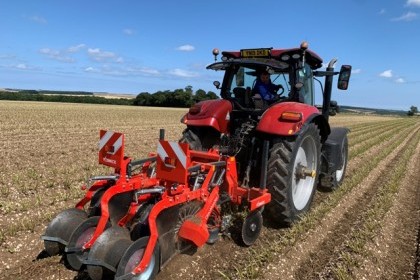The Vegniek DiscMaster LS200 precision haulm puller, supplied by Standen Imports, has seen its second season on trial with Branston Ltd.
Haulm pulling is a haulm destruction technique whereby the haulm is gently pulled from the plant, following pre-topping as opposed to using alternative methods of haulm destruction such as pre-topping and chemical desiccation.
Branston were keen to trial this haulm destruction method primarily for its disease reduction advantage as well as the reduction in time lag between haulm removal and harvest. Being chemical-free also means that it is advantageous not just for seed or organic growers but to all growers who seek to find ways of reducing input usage in the growing cycle.
Branston, this year have trialled a 0.5ha area of Laura seed crop in Yorkshire. Three beds were topped to a flail height of 8”, this being a critical height to get the best result out of the puller; too short and it reduces the percentage of pulled stems. The rows then had a pass with the Vegniek LS200 2-row DiscMaster haulm puller.
Martin Stothard, Technical Lead at Branston has overseen these trials and has been very impressed so far with the output from the machine.
“We decided to trial the Vegniek DiscMaster Precision haulm puller this year in a crop of Laura seed as the variety has a very upright growth habit and, as a result of the heat and drought, a thin canopy, making pulling very effective.”
During the DiscMaster single pass, forward speeds of 4km/h were achieved and the machine was more than 95% effective at pulling the stems, resulting in very little exposure of tubers out of the top of the ridge, despite the very dry soil conditions.
Two weeks post-pull assessments were carried out by Branston to look at 4 key areas on interest:
- Stolon detachment
- Skin set
- Size gain
- Disease loading
Martin noted that;
“the pulled crop had 100% stolon detachment two weeks after pulling compared to the fail + spray crop which still had 50% tubers tightly hanging on to the stolon’s. Skin set was 7-10 days ahead of the flail + spray crop, both of which are huge advantages to growers, allowing harvesting to commence sooner.”
With haulm pulling the moment of growth stop is immediate with efficient stolon separation. The hardening process takes much less time than relying on the time lag between herbicide application and it starting to be effective. The result is much less time between haulm pulling and harvest, with skin set achieved in as little as 10 days. This reduction in time between hardening and harvest also reduces the likelihood of rhizoctonia infection taking hold, particularly important for seed producers.
Branston also looked to see if the crop stopped bulking quicker, but due to the heat and drought, bulking rates were so low, no difference was seen between pull and flail + spray. Martin added;
"We did see a small reduction in latent bulking last year on the pulled sample as removing the tubers from the plant stops any pull back of nutrients and water normally seen as the plant dies back”.
No difference was seen either in terms of disease loading but Martin added;
“if harvest had taken place 7-10 days earlier than the flail + spray, latent disease risk would be greatly reduced”.
Branston will be following the Laura seed crop into store to look for signs of any deterioration on the tubers; this was also done last year and no detrimental effects were seen.
Late season virus control is also a major potential benefit of haulm pulling. Martin added;
“by removing all green leaf and stem by pulling, this eliminates the risk of re-growth which can often be a source of late potato virus Y ingress in seed crops. This is something we intend to look at in more detail when we continue trials next year.”
Branston feel the technology could prove extremely useful for organic growers as it is more sustainable and environmentally friendly compared to alternatives such as gas burning and intend to roll the method out into further trials covering seed, organic and ware crops next year.
The machine has also been on hire to some seed and ware growers both in North Yorkshire and Norfolk later on this season. Both growers had instances where the crops have been pre-topped and dessicated, yet, even after 8 weeks, post desiccation the crops were still hanging on. This was causing blockages in the harvesters where the haulm rollers couldn’t separate the tubers from the haulm. The growers both said “using the haulm puller has been the difference between us being able to harvest and not”.
The strength of the Vegniek model over other haulm pullers on the market is the near perfect sealing and pressing of the rows during the pass, sealing the crop inside the ridge and preventing crop damage as a result of exposure. The machine has a strong driveline, straight from tractor hydraulics, has simple and effective depth controls and low operating costs. The Vegniek DiscMaster comes in 2 and 4 row models, with a 6 row folding model in available for next season. For more information click here.

